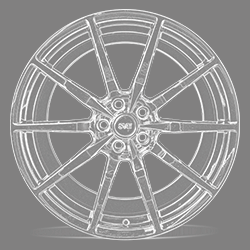Through lots of practice with an instructor. It took hundreds of landings for me to get to the point where I could land the plane on my own, and hundreds more to get to the point where I was reasonably proficient at it.
And that's with a process where you are dividing your attention between two things: the visual picture out the window, and the airspeed indicator, with the former getting the vast bulk of the attention.
In a way, I'm actually approaching driving the line the same way I approach landing the airplane. I'm using the sight picture out the window to guide my inputs. And just as with landing the airplane, at no time do I take my eyes off the sight picture for more than a fraction of a second. And that's despite the fact that landing the airplane is a relatively stable thing that only requires correctional inputs to account for changing wind conditions. Otherwise, it's essentially like driving in a straight line (actually, it's very much like driving a car in a straight line through gusty winds, except that you have two axes to manage instead of just one).
And here, I think, lies the eventual conclusion to the whole process.
Practice. If it took "hundreds" of landings before you feel you got it completely down, then I would say that it's quite possible that it will take
hundreds of laps to achieve the same level of competency and comfort.
One other factor that I'll bring up here about starting right in front of the hood... This is a common beginner mistake, and actually makes things a lot more difficult than it really needs to be. By staring at the track right in front of the car, the result of ANY control input is hugely magnified, compared to looking and judging based on a distant reference point. If you stare right in front of the car, you'll be making constant fine corrections and the workload from the feedback loop (see, correct, repeat) goes up dramatically compared to using a more distant point, say 700' or so down the track. Even when just driving in a straight line.
The same applies when taking a corner. If you stare at your turn in point until you actually turn in, and visually confirm that you have steering authority and
then lift your eyes up to apex, you're probably mid-way between turn-in and apex before you actually get focused on apex and start making decisions on your line placement. If, however, the instant you
commit to making turn-in, you lift your eyes up to track-out, the tendency towards constant, fine, fiddling corrections is drastically minimized. Point one: The car does
not "instantly" change direction and start moving in a straight line from point to point, it moves in an arc. Point two: If you have an appropriate turn-in point, and drive to exit, you WILL hit apex if you're on a geometric line, assuming you can get the car to track-out without wholesale steering corrections. Having your eyes up really helps there, as you tend to average out the corrections compared to staring right over the hood. Remember that a geometric line is a single, simple arc, and your
apex point is defined strictly by the radius of the arc (amount of steering input) and turn-in point. Turn in too soon, and you hit the berm at apex. Turn in too late, and your apex point is some distance away from the apex berm. The
late-apex line, by contrast, is a compound radius turn, starting with a tighter-radius section (initial turn-in through apex) than the geometric line, followed by a wider-radius section (apex through track-out) allowing you to start accelerating sooner. For a car like a Mustang, the late-apex line is certainly the preferred line, but in this case it may be easier to start with the geometric-apex line, and then modify once sufficient experience (comfort, situational awareness, muscle memory) is gained.
And yes, this is something that can be practiced on the street in complete safety! When doing street "practice" it's obviously unsafe to "use the whole track" however there's nothing to say you can't "use the whole
lane" as it were. This is particularly true of highway ramps that aren't cloverleafs, but describe a lazy "S" shape. Every time there is a direction change, make a habit of starting at the outside edge, apexing to the inside, then drifting back out again. You just might find that this path will also give you the smoothest (least lateral-G load at any given speed) ride as well. Focus on maintaining speed, but simultaneously minimizing G-load. Of course, keep your techniques together as well! Single, smooth wheel motion in, single smooth wheel motion out. On track, you're doing essentially the same thing, but instead of holding your speed constant, you're shooting for holding your lat-G load constant (at the edge of adhesion!) and maximizing speed relative to it!
In the end, I think this is just going to take time. Time to get used to the environment, time to get used to the pace, time to get used to the techniques, and then time to integrate it all.





